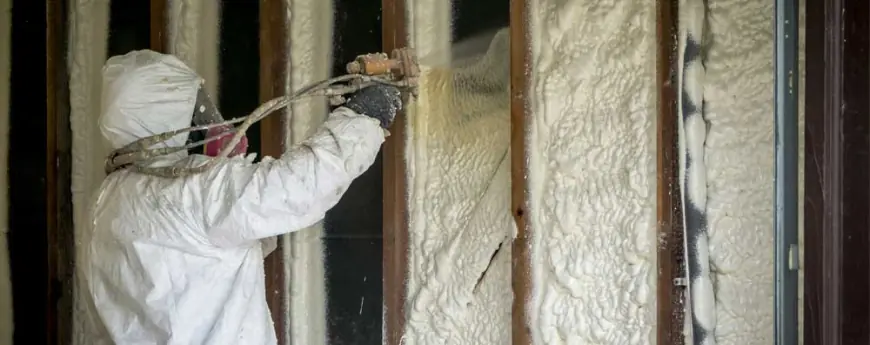Technical Advantages of Closed-Cell Spray Foam for Structural Reinforcement

Closed-cell spray foam is widely recognized for its high insulation value, but its role goes beyond energy efficiency. Its dense composition and rigid structure contribute to the reinforcement of walls, roofs, and subfloor systems. This makes it a material valued not only for thermal resistance but also for structural stability.
This article explores how closed-cell spray foam strengthens building assemblies, the science behind its rigidity, and why it is increasingly considered in both residential and commercial construction projects.
How Closed-Cell Spray Foam Provides Structural Reinforcement
Closed-cell spray foam insulation services forms a dense, rigid layer when applied, bonding tightly to surfaces. This creates a continuous barrier that strengthens building assemblies and reduces weak points in the envelope. Its high compressive strength and adhesive properties help stabilize both wood and metal structures.
Defining Structural Support in Spray Foam
Structural reinforcement in spray foam refers to the ability of the cured material to add stiffness and strength to the assemblies it covers. Unlike open-cell foam, closed-cell insulation maintains a solid form that supports both vertical and lateral loads.
Scientific Basis for Rigidity
Closed-cell spray foam contains tightly packed cells filled with gas, giving it higher density compared to open-cell alternatives. This density results in compressive strength values ranging from 20 to 60 psi, depending on formulation. That rigidity translates into added stability for walls, ceilings, and floors.
Key Technical Advantages for Buildings
The technical characteristics of closed-cell spray foam give it multiple advantages for structural reinforcement in different applications.
Increased Wall and Roof Stability
When applied between studs or rafters, closed-cell spray foam bonds directly to sheathing and framing. This adhesion reduces racking, which is the tendency of walls to shift laterally under wind or seismic stress.
Resistance to Moisture and Deformation
Closed-cell insulation resists water absorption, which prevents structural weakening caused by dampness. Its rigidity ensures it retains shape under load, preventing sagging or deformation over time.
Contribution to Load Distribution
Spray foam spreads stresses across wall assemblies by creating a rigid connection between framing elements and sheathing. This reduces localized pressure points that can lead to failure in traditional insulation systems.
Comparing Closed-Cell Spray Foam With Other Insulation Materials
To evaluate the structural reinforcement benefits, it helps to compare closed-cell spray foam with common insulation types.
The table shows that closed-cell spray foam uniquely provides both structural reinforcement and moisture resistance, while most other insulation materials contribute only thermal performance.
Real-World Applications of Closed-Cell Spray Foam Reinforcement
Closed-cell spray foam is used in a range of construction scenarios where reinforcement matters alongside insulation.
Residential Construction
Homeowners benefit from stronger walls, warmer basements, and more resilient roofing systems. In regions prone to storms or shifting soil conditions, spray foam adds stability by locking building components together.
Commercial and Industrial Facilities
Commercial structures often require materials that resist deformation under heavy use. Spray foam strengthens large wall panels and helps roofing systems withstand wind uplift. Warehouses and metal buildings benefit from both insulation and rigidity.
Extreme Climate Applications
In coastal or hurricane-prone areas, spray foam supports resistance to wind pressure. In cold climates, its moisture resistance helps protect structural framing from freeze-thaw damage.
Structural Reinforcement Beyond Insulation Value
Closed-cell spray foam provides both energy efficiency and structural durability. By reducing air leakage, preventing moisture ingress, and increasing wall rigidity, it strengthens the building envelope in ways that traditional insulation cannot.
Integration With Building Codes and Standards
Many energy codes recognize spray foam for its insulation value, but building professionals increasingly use it for added stability. Its contribution to shear strength and load resistance makes it a dual-purpose solution in modern construction practices.
Longevity and Durability
Closed-cell spray foam maintains its structural and insulating properties for decades. Unlike batt or loose-fill materials, it does not settle, compress, or degrade quickly, which preserves both energy performance and reinforcement benefits.
Conclusion
Closed-cell foam stands out among expert spray foam insulation services options for its ability to contribute to structural reinforcement. Its rigidity, adhesion, and moisture resistance provide more than just thermal efficiency. By bonding directly to surfaces and increasing stiffness, it strengthens walls, roofs, and floors.
For residents, this means added protection against weather and improved comfort. For commercial property owners, the material supports long-term durability and lower maintenance costs. Viewing closed-cell spray foam as both an insulator and a reinforcement tool reveals why it has become a preferred choice in modern construction.
FAQs
How does closed-cell spray foam reinforce structures? It bonds directly to framing and sheathing, creating a rigid barrier that increases stiffness and reduces movement under loads.
What is the compressive strength of closed-cell spray foam?
Depending on formulation, compressive strength ranges between 20 and 60 psi, making it much stronger than open-cell foam or fibrous insulation.
Does closed-cell spray foam improve roof durability?
Yes. It helps resist wind uplift by bonding to roof decks and adds rigidity to prevent shifting under extreme weather.
Can closed-cell spray foam prevent moisture damage?
Yes. Its closed-cell structure resists water absorption, protecting structural elements from mold, rot, and freeze-thaw damage.
Is closed-cell spray foam recognized in building codes?
It is recognized primarily for insulation, but many builders use it for added structural reinforcement in compliance with code requirements for durability and energy efficiency.
Reviewer: Olivia Thompson has spent 10 years working in spray foam insulation, helping companies grow their visibility. She reviewed this article and provided valuable suggestions on how to better align the content with the needs and expectations of customers, ensuring it resonates with the target audience.
What's Your Reaction?
 Like
0
Like
0
 Dislike
0
Dislike
0
 Love
0
Love
0
 Funny
0
Funny
0
 Angry
0
Angry
0
 Sad
0
Sad
0
 Wow
0
Wow
0



















































